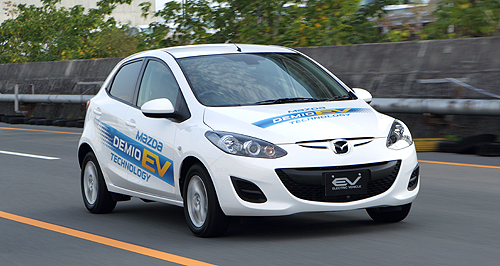Make / Model Search
News - MazdaMazda updates its electrification roadmapRemix to ignition: SkyActiv-X is the world’s first mass-production compression-ignition petrol engine and will make its debut in the next-generation Mazda3. SkyActiv-X to match EVs for emissions as Mazda rethinks electrification plans14 Mar 2018 MAZDA has updated its electrification roadmap, moving forward the release of its first pure-electric vehicle since the short-lived Mazda2/Demio EV, while also claiming that its imminent SkyActiv-X powertrain could rival pure EVs for ‘well-to-wheel’ carbon dioxide emissions. Under the Japanese car-maker’s original plans announced to Australian journalists at the Tokyo motor show last year, a pure EV was to launch in 2021 and a plug-in hybrid in 2019, but these releases have been changed to 2020 and 2025 respectively. However, an EV with a range-extender rotary engine remains on track for a launch next year, while mild hybrid technology will also be introduced in 2019. Specific details on these models remain under wraps, but the EV range-extender will likely be similar to the 2013 Mazda2/Demio TPEV prototype that used a single-rotor engine to charge its battery pack. Meanwhile, the pure EV is also likely to be a standalone model and will arrive as a product of the marque’s joint venture with Toyota and Japanese automotive supplier Denso. As previously reported, the majority of Mazda’s model line-up will feature at least one electrified powertrain option by 2030, with plug-in and mild hybrids set to play a key role in this roll out. The manufacturer already sells an electrified model, the Mazda3 Hybrid, but it is only sold in native Japan, borrowing its petrol-electric powertrain from the Toyota Prius. Despite its focus on electrification, Mazda remains committed to internal-combustion engines, as evidenced by the reveal of SkyActiv-X – the world’s first mass-production compression-ignition petrol engine – in August last year. According to the brand, the CO2 emissions of the SkyActiv-X powertrain are comparable to that of a pure EV if evaluated using the “more realistic” well-to-wheel methodology. When taking into consideration that fossil fuels are still used in about two thirds of global electricity production, Mazda argues that describing pure EVs as zero-emission models is misleading. Specifically, the well-to-wheel approach accounts for fuel extraction, manufacturing and shipping, as opposed to the traditional tank-to-wheel method that only highlights emissions while driving. Using a mid-size pure EV that consumes about 20kWh per 100 kilometres as an example, electricity production using coal translates to CO2 emissions of 200 grams per km, or 156g/km with petrol and 100g/km with LPG. When converted to a well-to-wheel figure, the average CO2 emissions of a pure EV are 128g/km depending on the electricity production source. Comparatively, the car-maker’s current SkyActiv-G engine of similar power output has CO2 emissions of 142g/km, meaning EVs are as little as 10 per cent more efficient on average. Given that SkyActiv-X promises to be 20 to 30 per cent more efficient than SkyActiv-G, Mazda believes it could be cleaner than a pure EV running on electricity produced using LPG. SkyActiv-X will make its first appearance in the fourth-generation Mazda3 small car that is scheduled to hit Australian showrooms next year. These zero- and low-emission efforts fall under the marque’s Sustainable Zoom-Zoom 2030 plan that aims to reduce its corporate average well-to-wheel CO2 emissions to 50 per cent of their 2010 levels by 2030 while on the way to 90 per cent by 2050.  Read more6th of December 2017  Mazda range-extender ‘great news’ for rotary fansRotary range-extender set for coming Mazda EV/hybrid in development now30th of October 2017  Tokyo show: Mazda plots EV coursePlug-in hybrid from Mazda planned by 2019 before electrification across line-up26th of October 2017  Tokyo show: Kai concept signals new Mazda3New-generation SkyActiv-X Mazda3 hatchback heralded by slick Kai concept11th of September 2017  Bumpy road to Mazda compression-ignition petrol unitMultiple problems kept Mazda’s boffins busy for years before the system worked10th of September 2017  Mazda ‘SkyActiv-X’ to run alongside current enginesNew blown compression-ignition engines to sell alongside current powertrains: Mazda8th of September 2017  Mazda backs future of diesel engineHi-tech SkyActiv-X oil-burner up next as Mazda keeps faith in diesel engines7th of September 2017  First drive: 2019 Mazda3 takes shapeIRS gone but Mazda’s torque-rich compression 2.0 and dynamic maturity a revolution |
Click to shareMazda articlesResearch Mazda Motor industry news |











Facebook Twitter Instagram